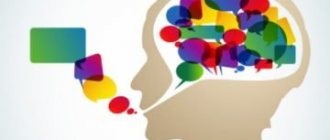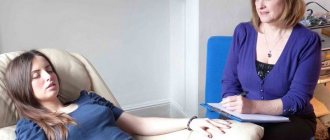Lack of balance and stress
Almost 60% of people have an imbalanced brain. With a predominance of the left hemisphere, there is an inability to relax and rest. This is hampered by internal tension and readiness to fight. This condition corresponds to the beta rhythm of the brain. Typically, the human brain is able to switch between alpha and beta waves throughout the day, which ensures mental stability, the connection between consciousness and the unconscious, and the ability to learn. Alpha waves are needed to connect the hemispheres and trigger the theta rhythm. People who are unable to relax by simply closing their eyes usually have difficulty falling asleep.
Counting sheep to fall asleep - the simplest mechanism of self-hypnosis
Why do sheep help? Counting is the prerogative of the left hemisphere. In a person with a dominant right hemisphere, excess load on less active areas will cause drowsiness. When the left hemisphere is dominant, logic prevails without creativity, and trying to hum a melody or come up with a rhyme will induce sleep. Simply, foreign activity slows down the brain even more.
Do you suffer from insomnia?
Not really
Brain activity during hypnosis
In terms of electrical brain waves, hypnosis resembles the physiological sleep pattern of a healthy person. If you conduct a study using electroencephalography, you can see the following picture:
- Peace, calm and sleepiness indicate theta wave activity with an oscillation range of 4-8 Hz. The borderline state between sleep and reality is characterized by vivid images, associative thinking, and creative outbursts.
- Drowsiness, during which the alpha rhythm is suppressed with a frequency of 8-13 Hz and the appearance of an almost straight line with fluctuations of weak amplitude.
- Sleep spindles or bursts of beta rhythm at frequencies of 13-16 Hz characterize the actual onset of sleep.
- Slow delta rhythm with frequencies of 1-4 Hz with ongoing sleep spindles.
- Slow waves with high-amplitude oscillations at a frequency of 0.5-2 Hz - delta sleep or hypnosis.
Kinds
There are several types of hypnosis for insomnia. The main types are:
- Classic hypnosis. This type is used much more often than others. During this procedure, the patient is given direct instructions. A person is put into a trance when suggestibility increases.
- Hypnosis by Milton Erickson. To influence the patient, several conditions must be met. There must be contact at the level of facial expressions. The specialist’s speech should be heartfelt.
- Regressive hypnosis. This is the most complex and interesting type. With its help, the patient can be immersed in memories of the past. In this state, a person can remember in detail not only his youth and childhood, but also his time in the womb.
- Self-hypnosis. All actions are performed using the method of self-hypnosis of certain attitudes.
- Gypsy hypnosis. This species is passed on between gypsies from father to son. It's very effective. Therefore, you should not communicate with gypsies and look them in the eyes.
The Importance of Theta Rhythm
Theta waves mark the descent into sleep, open the key to falling asleep and slowing down the rhythms of the brain. They are the ones who switch the brain from a state of thinking about the events of the past day to the phase of dreams, which lead to relaxation and healthy sleep.
The therapeutic importance of theta waves lies in their ability to provide a solution to any problem. The dream represents a re-recording of past events from the perspective of new experience and knowledge. For the brain, there is no difference between what is dreamed and what is seen, just as there is no difference between dreaming and sleeping.
For the brain there is no difference between sleep and reality
Inducing the theta rhythm is self-hypnosis by reading a hypnotic script, during which sleep occurs. True desires begin with a feeling of comfort and tranquility: “I feel comfortable and calm, allowing my head to lull me to sleep. I speak slowly and quietly, my body relaxes, every muscle relaxes with every word.” Then imagine and describe a sun lounger on a beautiful beach, a warm wind, the soothing sound of the sea, waves that wash away the burden of problems.
A small percentage of people are able to switch to the theta rhythm consciously. Creative people can do this. That is why there are categories of people who cannot be hypnotized.
Manifestations of obsessional neurosis
The most common manifestation of obsessional neurosis is fear, which is very difficult and sometimes almost impossible to overcome. Phobias make social contacts, work and all other aspects of life very difficult.
Another version of neurosis is, in fact, obsessive thoughts that a person cannot “drive” out of his head. These thoughts interfere with learning, concentration and greatly tire the patient. An important criterion: a person with obsessional neurosis never realizes his thoughts. The last type is compulsive. It manifests itself through obsessive movements and excessive ritualism.
Alpha rhythm and desires
Methods of the right hemisphere - active daydreaming - are used in the works of Jose Silva, who wrote the book “Reprogram yourself for money.” His method of inducing the alpha rhythm, which balances the hemispheres, can be used as hypnosis for sleep.
You need to lie down comfortably so that your back is straight and relaxed. Close your eyes, listen to your own breathing, waiting for it to become slower and deeper. Then repeat the word “three” three times, taking three inhalations and exhalations and imagining the number. Repeat the words “two” and “one” in the same way, without ceasing to visualize the numbers. Synchronization of breathing, visual, speech and auditory cortex will lead the brain to the alpha rhythm and provide relaxation.
Visualization of numbers
Without opening your eyes, imagine yourself sleeping, rested, relaxed. Visualize the flows of energy filling the body during sleep. Breathe slowly and deeply. Imagine a clock that shows the time of falling asleep with deep sleep and the time of waking up - the desired time when you want to wake up with a charge of vigor.
My competencies
As a hypnotherapist, I help my patients get rid of idiosyncrasies, manias, phobias, tics, panic attacks and other manifestations of diseases of a psychosomatic nature, such as:
- Causeless attacks of melancholy, horror, resentment, hatred, pity.
- Phobias associated with public speaking, judgment, strangers, sex, dating, confined spaces, talking on the phone.
- Fear of darkness, heights, speed, sounds of moving vehicles.
- Conditions of rapid heart rate, shortness of breath, nervous tics, skin rashes, depression.
- Addictions, including: overeating, alcoholism, gambling addiction, kleptomania, smoking, etc.
Breathing hypnosis
Breathing is measured and even - this is a light hypnosis that affects the parasympathetic nervous system through gentle stimulation of the vagus nerve. To fall asleep, you can use several breathing patterns:
- Place the tip of your tongue on the roof of your mouth behind your upper teeth. Close your mouth and inhale for a count of 4, hold your breath for a count of 7, exhale loudly for a count of 8. Repeat several times. With each night, relaxation will come faster, anxiety and stress will recede.
- Use an equal number of seconds to inhale and exhale, with a pause of the same number of seconds in between. Start with 5 and gradually increase to 10. Focus on exhalation, which relaxes the body.
- Breathe in 10 counts, focus on each number, imagine its color, shape, lines. The technique turns off attention and the left hemisphere.
Deep water technique
The first step is to imagine that you are lying on the water.
Scary dreams can interfere with falling asleep after a sudden awakening. It is necessary to undergo self-hypnosis “Phases of sleep”, imagining immersion in them, as if in water:
- The first phase is entering the theta rhythm. We imagine that we are lying on the water, and the waves lightly touch the neck, stimulating the relaxing activity of the vagus nerve. Arms and legs are relaxed and weightless.
- We dive under water, open our eyes, see light, air bubbles. We understand that we can breathe underwater and swim towards our desires - sleep and wake up refreshed.
- We head to the depths, imagining a clean sandy bottom, like a soft mattress. A cozy place away from problems, where the burden of problems has dissolved along with the weight of the body. Self-hypnosis in a borderline state treats anxieties and fears.
Sometimes the fear of falling asleep appears due to the habit of looking at a dream book after each dream. You just need to understand that dreams are the interpretation of past events by the subconscious. The future consists of our desires, the visualization of which before bed helps to fall asleep.
| Share: |
Similar materials
Are there any contraindications?
Treatment of insomnia with hypnosis is beneficial in most cases. According to doctors, you can fall asleep soundly from hypnosis even with:
- presence of signs of an excited psycho-emotional state;
- prolonged stress;
- mental and physical fatigue;
- severe disruption of the biological cycle; m
- taking medications, which led to sleep disturbances.
Achieving the desired relaxation and falling asleep is possible only after undergoing appropriate treatment. When the main factors influencing insomnia have been eliminated, hypnotic influence can be taken up. The list of contraindications also includes:
- oncological diseases, especially in acute form;
- coma;
- conscious reluctance to succumb to hypnotic influence;
- diseases of the cardiovascular system;
- epilepsy.
https://www.youtube.com/watch?v=dT5DWV6ktrI
What are obsessions, their danger to humans
Obsessive thoughts can be accompanied by other dangerous conditions - increased anxiety, depression, apathy, mental abnormalities. Obsessions often coexist with a person’s compulsive actions—an obsessive behavior pattern.
If we talk about the reasons for the occurrence of this condition, psychologists and psychiatrists cannot name an exact and single reason. The most common ones include:
- congenital - the structure of the brain, which leads to the peculiar functioning of the nervous system;
- complexes in childhood;
- psychological trauma and traumatic situations;
- severe overwork and constant stress.
If you do not start fighting obsessive thoughts, a person’s condition gradually worsens, he becomes nervous and irritable, and relationships with others, family and friends deteriorate. There can be a huge number of negative consequences, so it is important not to start the problem, but to start fighting it.
How to do auto-training
To practice auto-training, you do not need any special abilities, but you need to master the technique. You can acquire autogenic training skills in classes with a hypnotherapist or on your own. For this, there are special video lessons prepared and recorded by a psychotherapist who knows the technique of hypnosis.
Autotraining involves immersing yourself in a state of light trance. It is not dangerous and anyone can do it. As has already been said, trance is a natural state. We involuntarily and often unnoticed by ourselves can go into a trance state for several moments more than once during the day. This is how our brain protects itself from overload.
But in order to master the art of consciously immersing yourself in a trance, you still need some skills, and they are acquired in the process of training sessions.
It is also important to create a comfortable environment, take a comfortable position, and perhaps turn on soothing music. And make sure that nothing distracts you during the auto-training process.










